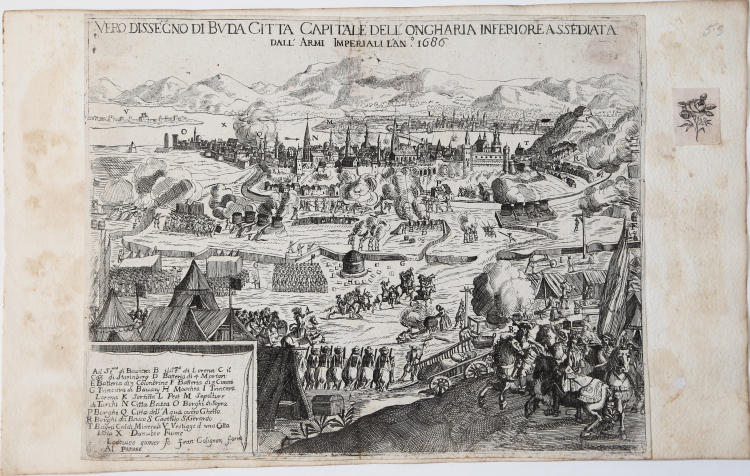



| Reference: | S43454 |
| Author | François COLLIGNON |
| Year: | 1686 |
| Zone: | Budapest |
| Measures: | 360 x 285 mm |


| Reference: | S43454 |
| Author | François COLLIGNON |
| Year: | 1686 |
| Zone: | Budapest |
| Measures: | 360 x 285 mm |
Very rare broadsheet made to document the 1686 siege of Budapest.
The cartouche at the top reads: VERO DISSEGNO DI BVDA CTTTA CAPTTALE DELL ONGHARIA INFERIORE ASSEDIATA / DALE'ARM! IM PER IA LI LAN.0 1686.
Bottom of engraver's signature and Collignon excudit: Lodouico gamier sc. Fran Colignon form. In Parion.
The 1686 siege of Buda was the second attempt by the Austrian army to conquer the Turkish-held Hungarian city after the failed siege two years earlier. The operation took place during the course of the Austro-Turkish War of 1683/89, lasted two and a half months and ended with the conquest of the Hungarian capital by the Austrian army and the defeat of the Turkish army.
During the course of the Fifth Austro-Turkish War, two years after the failed siege of Buda in 1684, a second military campaign to conquer the Hungarian capital began, in which an army of about 74,000 soldiers took part, almost double the size of the previous unsuccessful siege. In command of the army was still the Duke of Lorraine, Charles V, and the Turkish reinforcement army to the besieged was still under the command of Abdurrahman Abdi Pasha. The imperial army, in addition to Austrian soldiers was composed of Germans, Hungarians, Czechs, Italians, French, Swedes and other European volunteers.
The siege began in mid-June. In mid-August a Turkish reinforcement army under the command of Sarı Süleyman Pasha appeared before Buda but the Turkish commander feared a clash with the besieging army. The latter then succeeded on September 2, 1686, in capturing the walled city. During the final assault it was Prince Eugene of Savoy's dragoons who covered the imperial army's rear from possible attacks by Sarı Süleyman Pasha's Turkish army.
François Collignon (or Louis François, c. 1609 – 18 January 1687) was a French engraver, print-seller and publisher. Collignon was born in Nancy, France. He initially locally trained in the studio of Jacques Callot, in 1626 for four years (see Marot in GBA 85 1975, p.24), in 1631 in Augsburg and in 1634 in Rome. Returned to Paris by 1636, where worked with Israel Henriet on Callot estate, but also for other publishers; Della Bella godfather of his son Etienne baptised in Paris in 1643. Settled in Rome with his French wife in 1646/7, where seems to have worked less as a printmaker, but became major figure as publisher. His early work in Rome was published jointly with Orazio Marinaro. His print shop in Rome was in San Tommaso in Parione alla cantonata del vicolo della posta vecchia del Papa incontro al Toson d'oro.
Bibliografia
J. Kuhnmünch, 'Un marchand d'estampes à Rome au XVIIs', BSHAF 1978, pp.79-100; Ganado (1994): p. 180, n. 26.
François COLLIGNON (Nancy 1609 - Roma 1687)
|
François Collignon (or Louis François, c. 1609 – 18 January 1687) was a French engraver, print-seller and publisher. Older sources call him for some reason Jean Baptiste with completely wrong dates; they have been superseded by Kuhnmunch's publication of his posthumous inventory.
Collignon was born in Nancy, France. He initially locally trained in the studio of Jacques Callot, in 1626 for four years (see Marot in GBA 85 1975, p.24), in 1631 in Augsburg and in 1634 in Rome. Returned to Paris by 1636, where worked with Israel Henriet on Callot estate, but also for other publishers; Della Bella godfather of his son Etienne baptised in Paris in 1643. Settled in Rome with his French wife in 1646/7, where seems to have worked less as a printmaker, but became major figure as publisher. His early work in Rome was published jointly with Orazio Marinaro. His print shop in Rome was in San Tommaso in Parione alla cantonata del vicolo della posta vecchia del Papa incontro al Toson d'oro.
He produced works for aertist including Pietro Testa, Cornelis Bloemaert, Pietro da Cortona, Nicolas Poussin, Charles Le Brun, Simon Vouet, and Jean Le Pautre. He died in Rome January 18, 1687.
The Flemish publisher and engraver Arnold van Westerhout who lived in Rome at that time bought the stock of François Collignon after his death, for 4.200 scudi.
|
François COLLIGNON (Nancy 1609 - Roma 1687)
|
François Collignon (or Louis François, c. 1609 – 18 January 1687) was a French engraver, print-seller and publisher. Older sources call him for some reason Jean Baptiste with completely wrong dates; they have been superseded by Kuhnmunch's publication of his posthumous inventory.
Collignon was born in Nancy, France. He initially locally trained in the studio of Jacques Callot, in 1626 for four years (see Marot in GBA 85 1975, p.24), in 1631 in Augsburg and in 1634 in Rome. Returned to Paris by 1636, where worked with Israel Henriet on Callot estate, but also for other publishers; Della Bella godfather of his son Etienne baptised in Paris in 1643. Settled in Rome with his French wife in 1646/7, where seems to have worked less as a printmaker, but became major figure as publisher. His early work in Rome was published jointly with Orazio Marinaro. His print shop in Rome was in San Tommaso in Parione alla cantonata del vicolo della posta vecchia del Papa incontro al Toson d'oro.
He produced works for aertist including Pietro Testa, Cornelis Bloemaert, Pietro da Cortona, Nicolas Poussin, Charles Le Brun, Simon Vouet, and Jean Le Pautre. He died in Rome January 18, 1687.
The Flemish publisher and engraver Arnold van Westerhout who lived in Rome at that time bought the stock of François Collignon after his death, for 4.200 scudi.
|